Phase Space is a DIY makerspace, multimedia art studio, and experimental collective based in Brooklyn, NY.
We are dedicated to the exploration of video, sound, performance, creative coding, math + science, and interdisciplinary art practices.[1]
Phase Space is a DIY makerspace, multimedia art studio, and experimental collective based in Brooklyn, NY.
We are dedicated to the exploration of video, sound, performance, creative coding, math + science, and interdisciplinary art practices.[1]
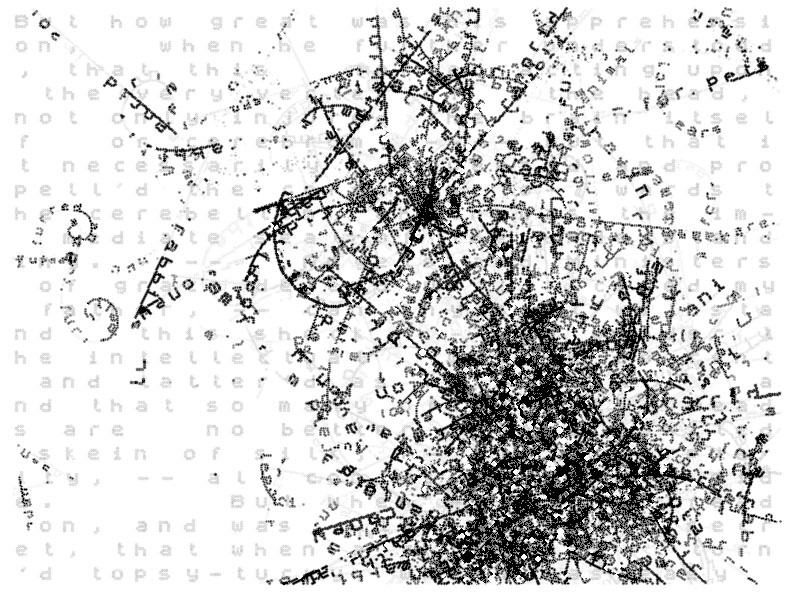 die.txt (2005), a bio-engineered text editor. As the user types, individual words spawn outgrowths of alternative meanings and definitions.
die.txt (2005), a bio-engineered text editor. As the user types, individual words spawn outgrowths of alternative meanings and definitions.
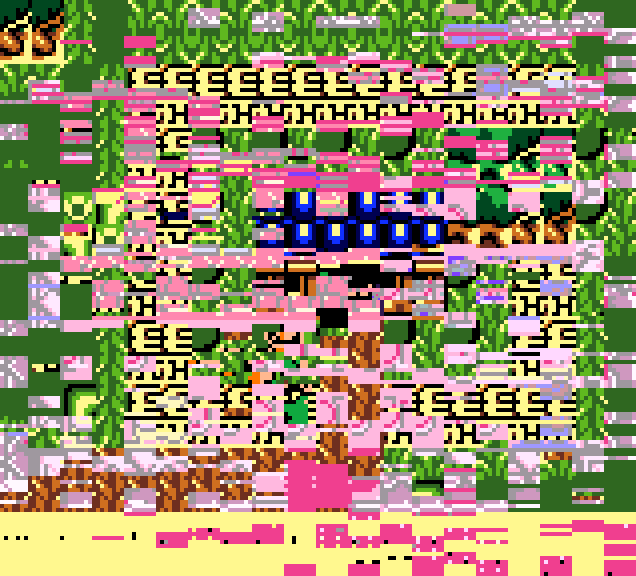 gameboy_ultraF_uk (1997-1999), consists of a Free Software Game Boy emulator whose rendering system has been (pathologically) rewritten to degenerate over time.
gameboy_ultraF_uk (1997-1999), consists of a Free Software Game Boy emulator whose rendering system has been (pathologically) rewritten to degenerate over time.
 Mesh (2001-2002), a sci-art 2000 research and development project dealing with the subject of self-organising networks.
Mesh (2001-2002), a sci-art 2000 research and development project dealing with the subject of self-organising networks.
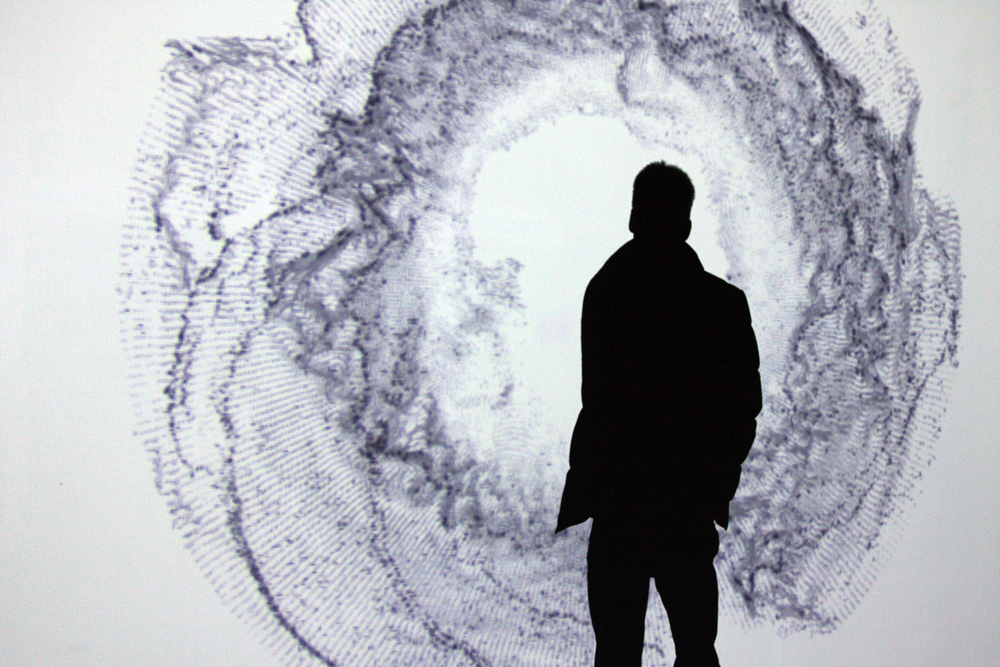 Southern Ocean Studies (2009-2011), part of a series of projects which aims to explore how climate models can function as representations of climate change beyond their original scientific contexts and purpose and exists as a large screen-based installation driven by live and archived data sets.
Southern Ocean Studies (2009-2011), part of a series of projects which aims to explore how climate models can function as representations of climate change beyond their original scientific contexts and purpose and exists as a large screen-based installation driven by live and archived data sets.
Reconnoitre is the artist duo of Gavin Baily and Tom Corby. Since the 1990s they have collaborated on artworks, texts and research that broadly explore intersections of environmental, technological and social processes. Recent work includes the use of information from the climate, meteorological and geological record to visually condense the aleatory and hidden aspects of environmental sites and landscape, and the employment of social media platforms to produce speculative geographies and experimental maps. At the heart of much of this work is an interest in data, employed as a medium beyond a conventional analytics approach, but which stresses its critical, experiential and affective potential.[1]
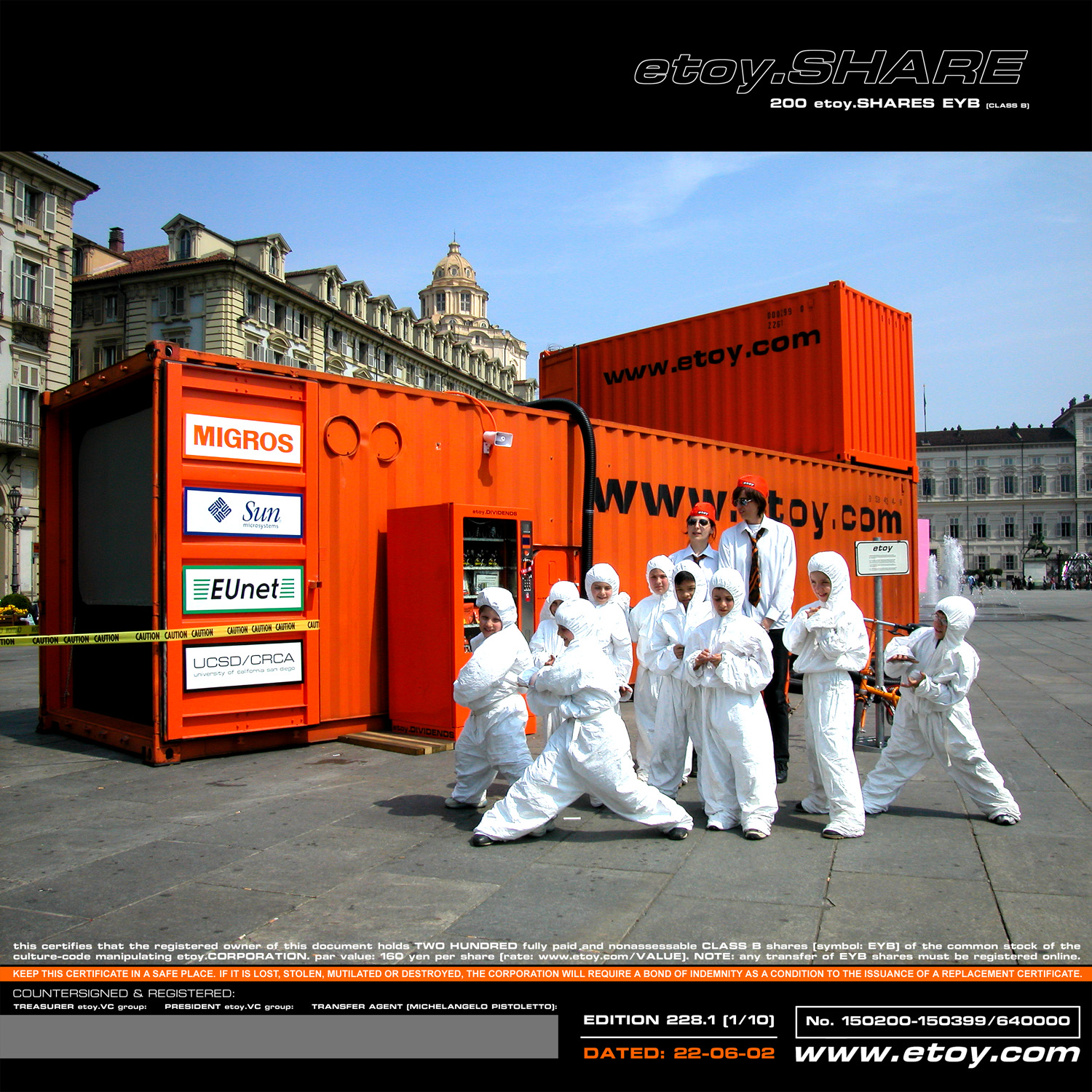 Etoy share certificate
Etoy share certificate
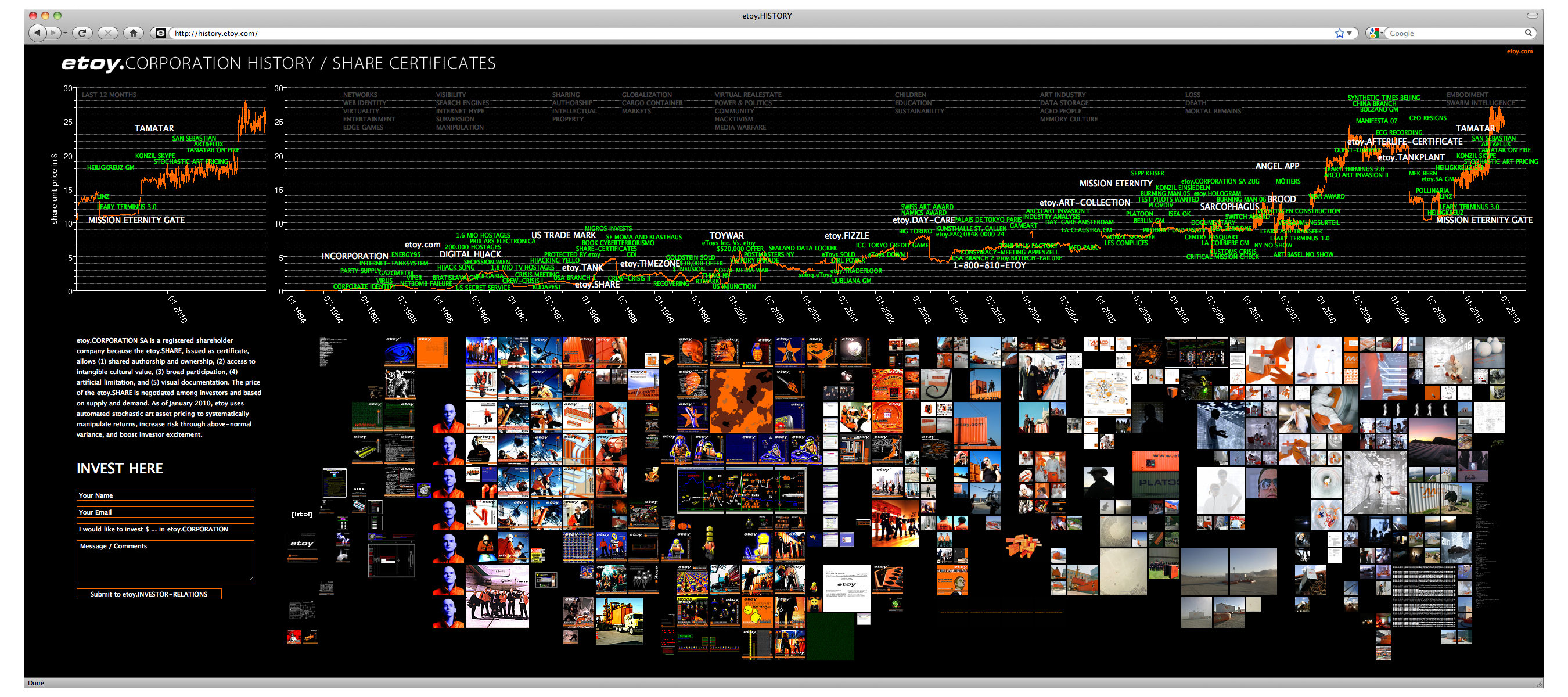 Etoy corporation history
Etoy corporation history
 Etoy hologram
Etoy hologram
 Who owns Etoy?
Who owns Etoy?
 Etoy share certificate
Etoy share certificate
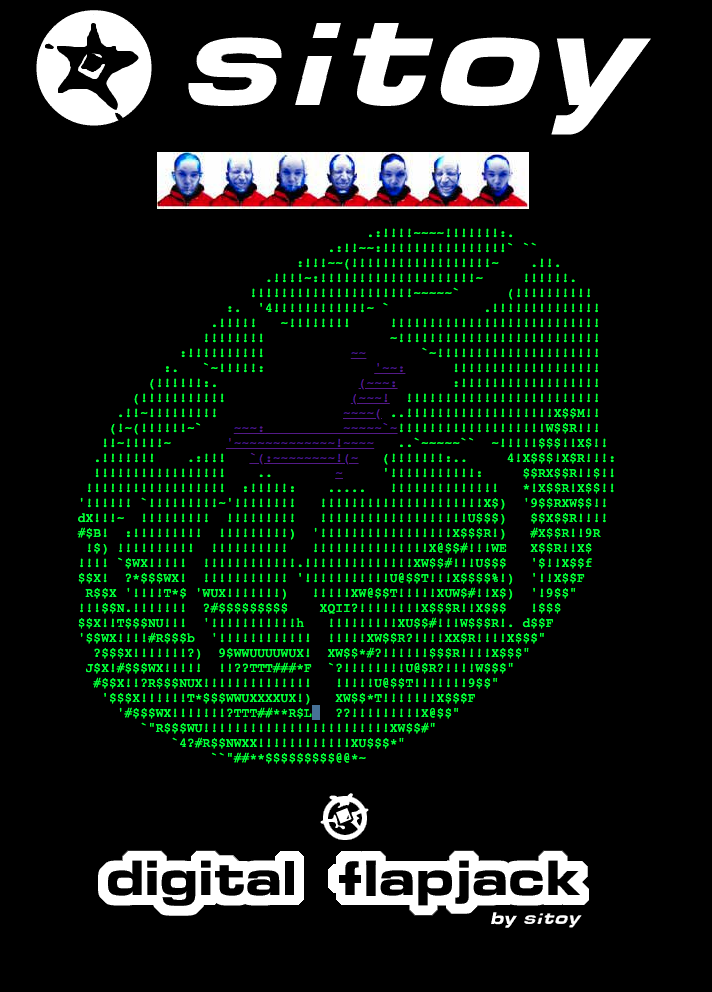 Digital Flapjack, part of Digital Hijack
Digital Hijack (1996)
Digital Flapjack, part of Digital Hijack
Digital Hijack (1996)
etoy.CORPORATION, an art group registered as a Swiss corporation, has been using internationally standardized (physical, virtual, legal and technical) containers to construct a global corporate sculpture since 1994. This "corporate sculpture" serves no purpose other than art - that is, the reflection of contemporary culture and its critical interaction with it.[1]
etoy.CORPORATION is art and invests all resources in the production of art beyond traditional dimensions. The aim is to take the resources, tools and legal framework of our time to create a corporate sculpture - a shareholder company registered in Zug/Switzerland that has no other purpose than cultural value. The privately held company etoy.CORPORATION SA issues etoy.SHARES (more information) to compensate its artists, investors, collectors and supporters. etoy.VENTURE association was founded 1994 and is registered in Zurich. This non-profit organization operates etoy.TANK-PLANTS in various cities, takes care of etoy.SOCIAL-ACTIVITIES, runs etoy.DAY-CARE and establishes MISSION ETERNITY - a digital cult of the dead. [2]
In the years 1999 to 2001, there was also a brand and domain name conflict with the American company eToys Inc., which became the largest online toy retailer during the boom years and reached a peak market value of around 10 billion US dollars. The fight for the rights to etoy.IDENTITY went down in history as a "TOYWAR" and is now part of textbooks. More than 400 international media have reported (from the New York Times and CNN, Art in America, to the Wall Street Journal). The group etoy has rejected very high financial offers of the counterparty precisely because the defense and preservation of the abstract identity container (TRADE MARK) in the case of etoy is much more important than the identity of the individual agents.[1]
 Codame Logo designed by Vicente Montelongo
Codame Logo designed by Vicente Montelongo
 Codame Art+Tech Festival 2018
Codame Art+Tech Festival 2018
 Codame Art+Tech Festival 2013
Codame featured artists reel 2014
Codame Art+Tech Festival 2013
Codame featured artists reel 2014
CODAME shapes the future through inspiring experiences and playful ART+TECH projects. CODAME events, installations, and workshops connect people of all specialties and backgrounds. Join us to continue the visionary celebration, running since 2010! [1]
Leveraging technology for creativity requires cultivation. By valuing questions over answers CODAME creates spaces encouraging exploration and discovery. Artists, entrepreneurs, innovators, amateurs, and leaders are all welcome on our journey. Startups, corporations, non-profits, and collectives alike have participated in CODAME style way-finding! [1]
 JODI Homepage
JODI Homepage
 MATERIAL WANT is the first collaboration of artist/researcher Matthew Plummer-Fernandez and net art pioneers JODI.
MATERIAL WANT is the first collaboration of artist/researcher Matthew Plummer-Fernandez and net art pioneers JODI.
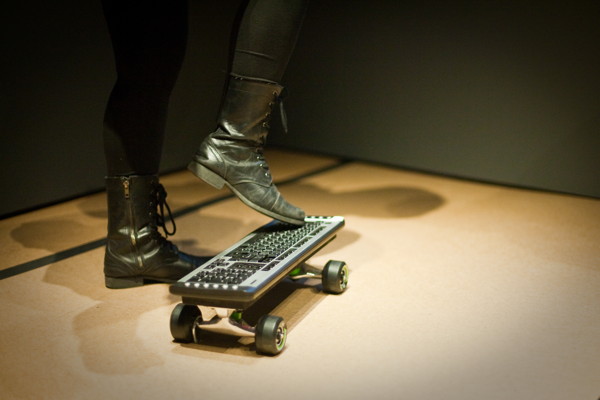 JODI, “SK8MONKEYS ON TWITTER”
JODI, “SK8MONKEYS ON TWITTER”
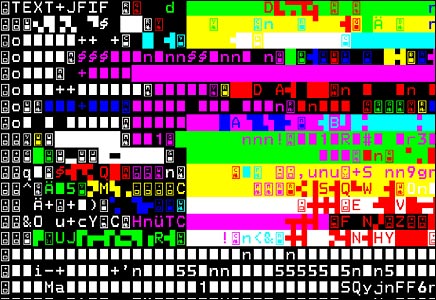 http://text.jodi.org
http://text.jodi.org
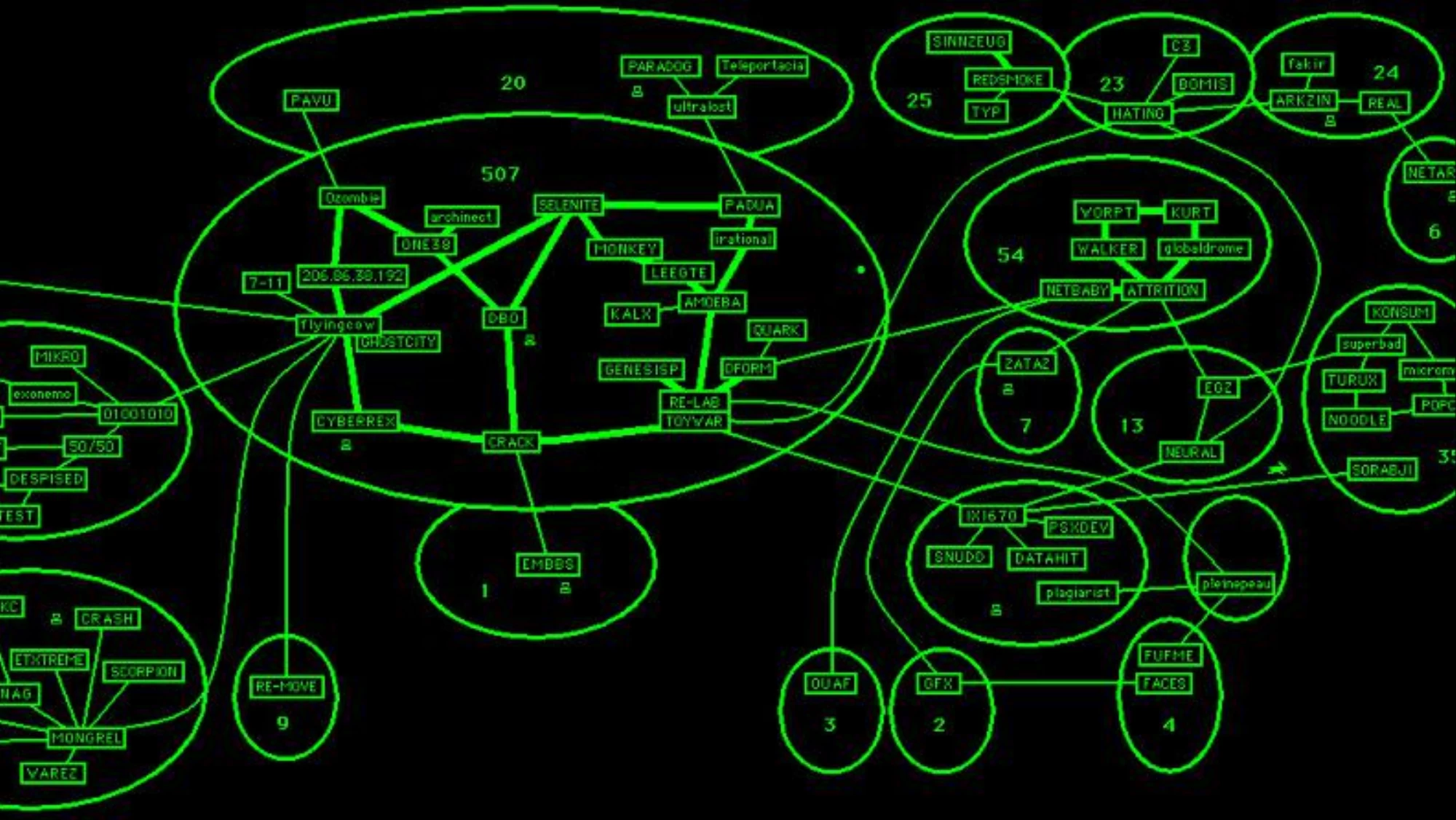 JODI's map of the internet
JODI: Street Digital_ Museum of the Moving Image, March 31--May 20, 2012 by [dNASAb]
JODI's map of the internet
JODI: Street Digital_ Museum of the Moving Image, March 31--May 20, 2012 by [dNASAb]
Internet provocateurs JODI pioneered Web art in the mid-1990s. Based in The Netherlands, JODI (Joan Heemskerk and Dirk Paesmans) were among the first artists to investigate and subvert conventions of the Internet, computer programs, and video and computer games. Radically disrupting the very language of these systems, including interfaces, commands, errors and code, JODI stages extreme digital interventions that destabilize the relationship between computer technology and its users. [1]
JODI (Joan Heemskerk and Dirk Paesmans) was formed in 1994. Joan Heemskerk was born in 1968 in Kaatsheue, The Netherlands. Dirk Paesmans was born in 1965 in Brussels, Belgium. Heemskerk and Paesman both attended Silicon Valley's electronic arts laboratory CADRE at San Jose State University in California; Paesmans also studied with Nam June Paik at the Kunstakademie in Dusseldorf. JODI's works are typically seen online. Their recent solo exhibitions include INSTALL.EXE at Eyebeam, New York, which toured to [plug-in], Basel, and BuroFriedrich, Berlin; and Computing 101B at FACT Centre, Liverpool, England. Their works have also been exhibited at Centre for Contemporary Art, Glasgow; Kunstverein Bonn; Stedelijk Museum, Amsterdam; Zentrum fur Kunst und Medientechnologie, Karlsruhe, Germany; Documenta X, Kassel, Germany; Harvard Art Museum, Massachusetts; EAI at ICA, Phillidelphia; and Lisson Gallery, New York, among many others. [1]
Misusing technological tools and languages has been a trademark for Jodi.org (Joan Heemskerk and Dirk Paesmans) since the mid-nineties, when they emerged as the pioneers of a movement which later became internationally known as net.art. Starting by applying this creative strategy to browsers, subverting websurfing logics and hacking the graphic interface, they then moved to videogames and finally to the so-called Web 2.0, deconstructing platforms such as Blogger, Google Maps and now Twitter. [2]
Selected net art pieces [3]
One of the most important collectives to emerge in the last decade, Paper Rad exploded at the edge of a cultural time zone—before the social web—when subculture was still palpable and also clearly becoming impossible to sustain. They emerged in the early ’00s within a community dedicated to DIY art practice that had strong roots in Providence, Rhode Island, as well as cities like Detroit, Baltimore, Boston, and towns in Western Massachusetts became known for a cartoon cosmos that felt like a psychedelic, subversive response to American pop culture that was hatched out of a sincere and deep engagement to it. Their work began with ’zines and music, and eventually grew to encompass digital animation, videos, installations, and their website—paperrad.org—which became an increasingly central part of their work as it drew attention and followers. [1]
… the page was changed daily, continually layered with new content or reorganized spatially. Amid this constant development, there are a few distinguishing elements to the website that endured throughout its seven-year life. First, it carried over the DIY ethos and aesthetics from the culture from which it emerged—paperrad.org was not an easy-to-navigate online artist’s CV but existed more like a maze of found, remixed, and original content. Visitors were only able to track the identities of participating members through deep research, which lent the site a mysterious and open feel, as if Paper Rad could be as small as one person or as large as a thriving subculture. A second distinguishing factor was that Paper Rad created their own discreet world that blended influences from both analog and digital culture. In the Paper Rad cosmos, hacked and re-versioned My Little Ponies mingled with animated gifs and characters originally rendered in printed ’zines, like Tux Dog, which were digitized and made open source. This straddling of different pop cultural realms—television and the internet, mass media and amateur media—became a trademark of Paper Rad, as did a disregard for medium specificity. The Paper Rad website, presenting recycled cartoon characters like Gumby in Flash animation sagas, was evidence of the eroding boundaries between media we are so familiar with today. [1]
Paper Rad's visual projects often employ bright fluorescent palettes juxtaposed with primary colors to create a distinctive "lo-fi" look. It adopts a variety of techniques and elements to achieve this look, including pop art, collage, punk art, as well as imagery from popular culture. The multimedia projects incorporate MIDI audio, poor recordings of original sound effects and voices, pixelization, and other crude audio and visual components. Paper Rad recycled or appropriated obscure sounds and images from a variety of sources, including old cartoons, commercials, and late-night television. [2]
The collective–which consisted of siblings Jessica and Jacob Ciocci, Ben Jones, and other collaborators–cultivated a unique interest in exploring artistic strategies from other media, especially comics and zines, through web-based and multimedia works. Serially updated during the group’s most active period (2001-2008), paperrad.org was both an archive and a artwork, a riot of brightly colored compositions featuring graphics and a mazelike compilation of characters from otherwise overlooked aspects of ’70s and ’80s pop culture. [3]
Paper Rad Homepages 01-08 Collected by Rhizome
Selected Webpages
The Hackers of Resistance (HORs) is a queer transfeminist hacker collective of artists, activists, researchers, cyborgs, witches, and technologists, of color. Co-conspirators, we build tools to defend our community, educate people to be secure, to demand and make ourselves heard, to fight back and hack tools of oppression. H0Rh0use is 0ur imm3rsive mUltim3dia heisT.
From Ada Gender New Media & Technology:
Hackers of Resistance (HORs) is a hyperreal-multimedia-installation-performance-video-game reimagining feminist activism. It’s immersive theater, video installation, and game design—but mostly, it’s a universe. A power fantasy of the oppressed, we subvert traditionally-white-American-centered dystopian narratives by placing WoC hackers as superheroes willing to risk it all for solidarity (our vision of utopia). Our stylized hyperreality uses shimmery-neon aesthetics, socially-aware comedy, and DIY charm to address serious concerns like the fate of minorities in the hands of the current administration. Some of the projects the HORs are developing and tinkering with are cybersecurity labs, anti-facial recognition, counter-surveillance, social engineering, bio-hacking, dildo-hacking, and DIWO 3D printable abortion kits in collaboration with our incarcerated sister organization Marias Clandestinas.
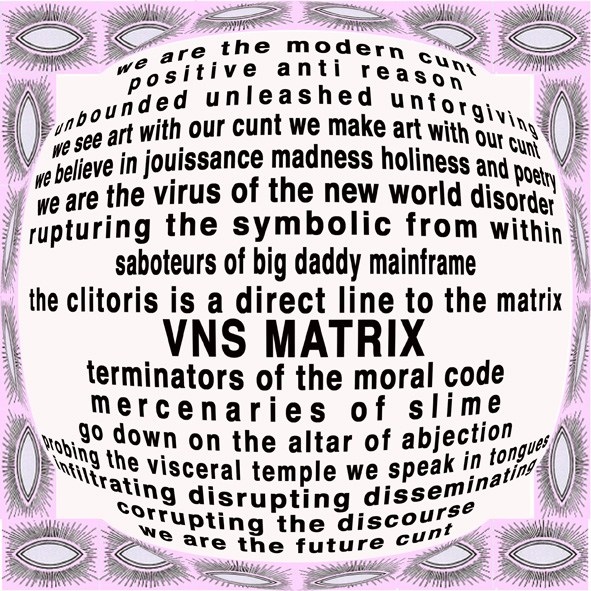 A Cyberfeminist Manifesto for the 21st Century, 1991, via VNS Matrix
A Cyberfeminist Manifesto for the 21st Century, 1991, via VNS Matrix
 Screen from All New Gen, 1992, via VNS Matrix
Screen from All New Gen, 1992, via VNS Matrix
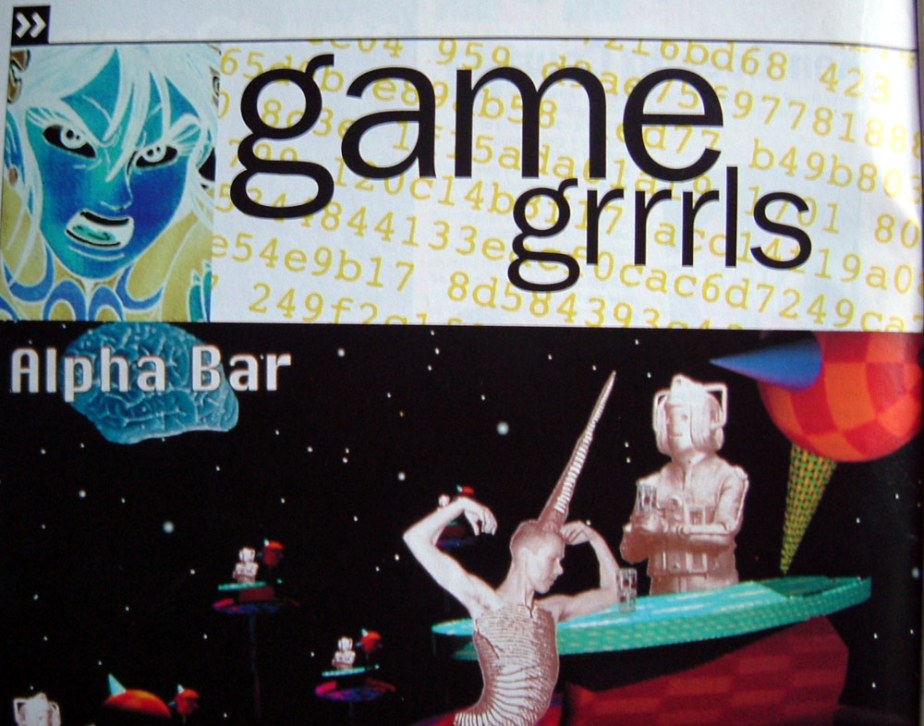 Via VNS Matrix
Via VNS Matrix
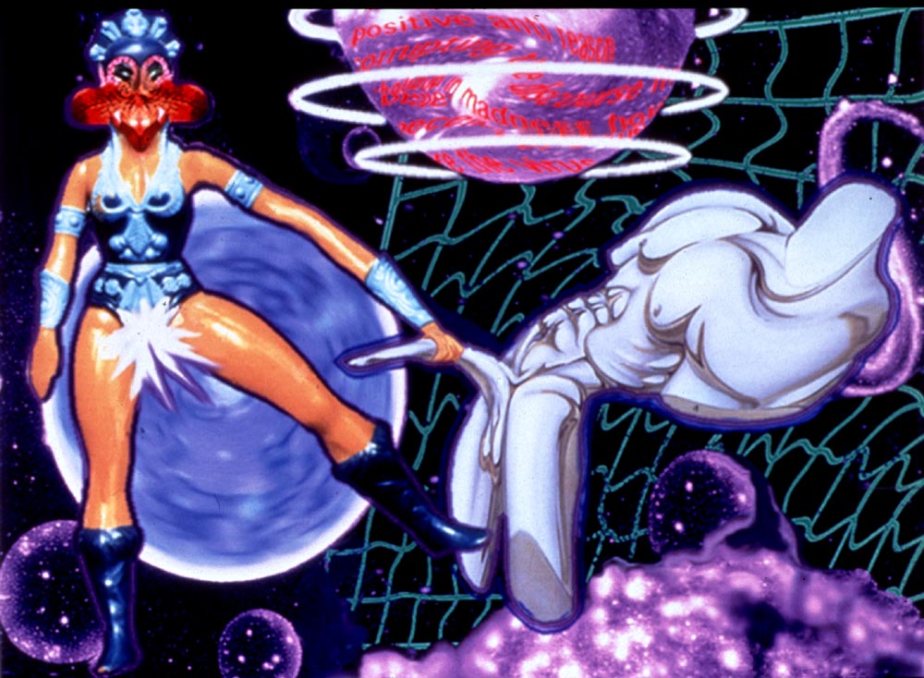 Screen from All New Gen, 1992, via VNS Matrix
Screen from All New Gen, 1992, via VNS Matrix
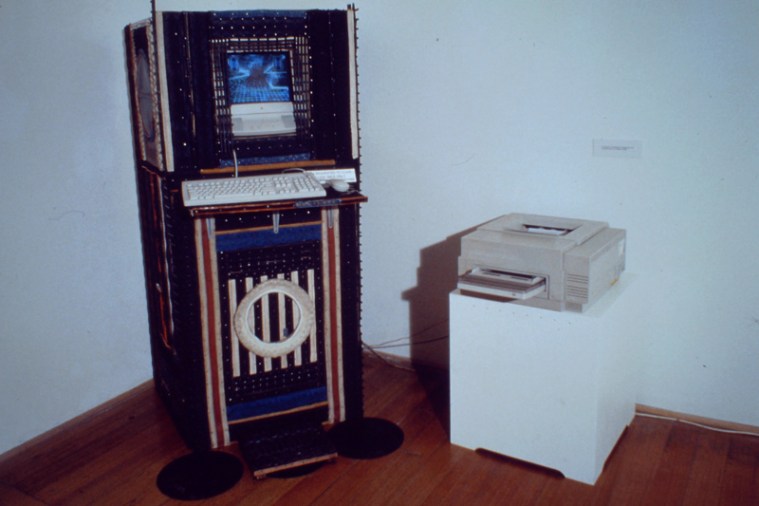 Installation of All New Gen, 1992, via VNS Matrix
Installation of All New Gen, 1992, via VNS Matrix
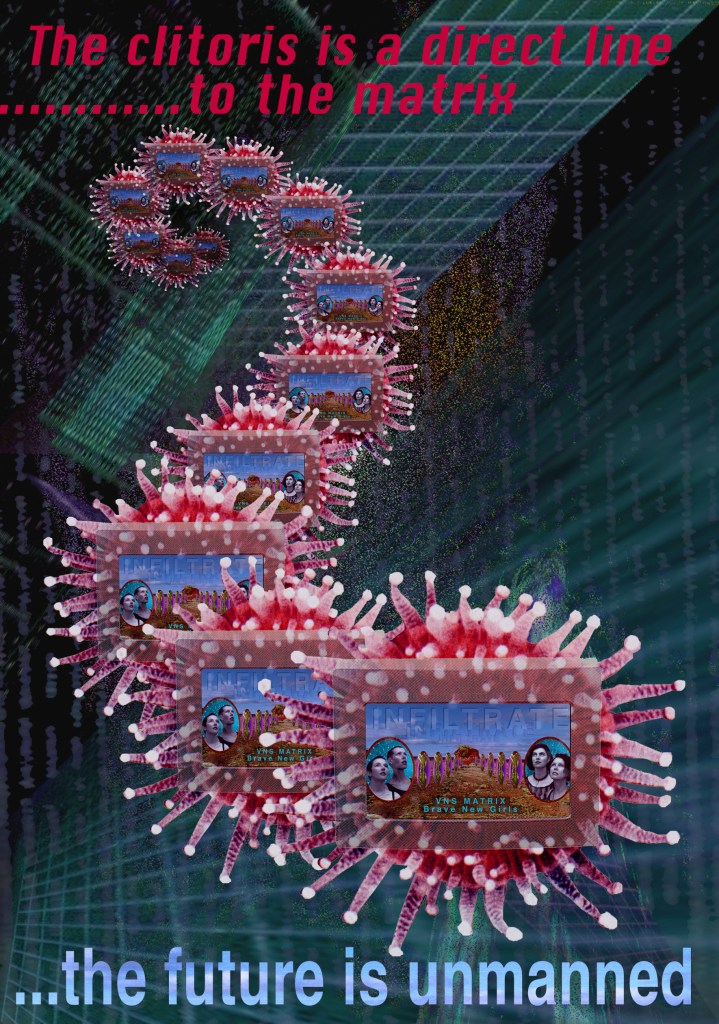 Ensensual Fragments ACCA public poster project, 1994, 1991, via VNS Matrix
Ensensual Fragments ACCA public poster project, 1994, 1991, via VNS Matrix
From Wikipedia:
VNS Matrix was an artist collective founded in Adelaide, Australia, in 1991, by Josephine Starrs, Julianne Pierce, Francesca da Rimini and Virginia Barratt. Their work included installations, events, and posters distributed through the Internet, magazines, and billboards. Taking their point of departure in a sexualised and socially provocative relationship between women and technology the works subversively questioned discourses of domination and control in the expanding cyber space. They are credited as being amongst the first artists to use the term cyberfeminism to describe their practice.
From VNS Matrix:
The first of their works (a large scale billboard), inspired by such theorists as Donna Haraway and Sadie Plant, featured their seminal text “A Cyberfeminist Manifesto for the 21st Century”. It was in this manifesto that the term “cyberfeminism” first appeared, and this work was widely distributed. In the manifesto, VNS Matrix stated that, “we are the modern cunt/positive anti reason/unbounded unleashed unforgiving” and that, “we are the virus of the new world disorder/rupturing the symbolic from within/saboteurs of big daddy mainframe/the clitoris is a direct line to the matrix/the VNS Matrix”. The group disbanded in 1997, but occasionally work together on selected projects and presentations. Their parting manifesto “Bitch Mutant Manifesto” gave the finger to all technopatriarchies and capitalist infospheres with the words “suck my code” amongst other blasphemous exhortations.